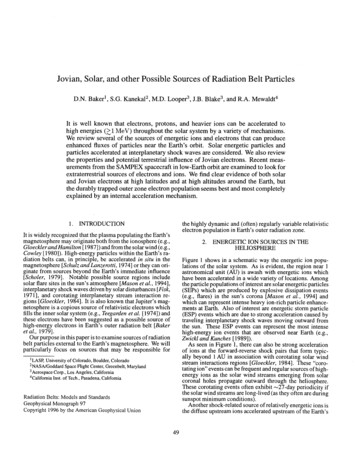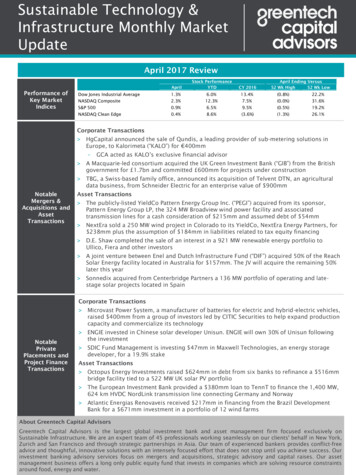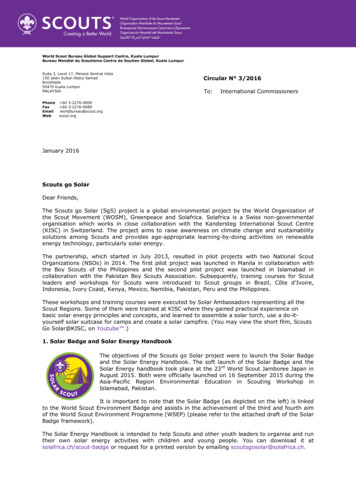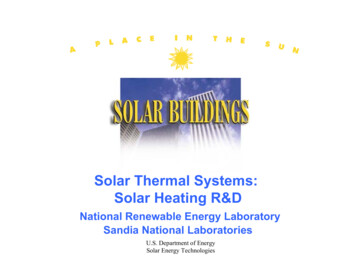
Transcription
Jovian, Solar, and other Possible Sources of Radiation Belt ParticlesD.N. Baker 1, S.G. Kanekal 2 , M.D. Looper3, J.B. Blake3 , and R.A. Mewaldt4It is well known that electrons, protons, and heavier ions can be accelerated tohigh energies ( 1 MeV) throughout the solar system by a variety of mechanisms.We review several of the sources of energetic ions and electrons that can produceenhanced fluxes of particles near the Earth's orbit. Solar energetic particles andparticles accelerated at interplanetary shock waves are considered. We also reviewthe properties and potential terrestrial influence of Jovian electrons. Recent measurements from the SAMPEX spacecraft in low-Earth orbit are examined to look forextraterrestrial sources of electrons and ions. We find clear evidence of both solarand Jovian electrons at high latitudes and at high altitudes around the Earth, butthe durably trapped outer zone electron population seems best and most completelyexplained by an internal acceleration mechanism.I.INTRODUCTIONthe highly dynamic and (often) regularly variable relativisticelectron population in Earth's outer radiation zone.It is widely recognized that the plasma populating the Earth'smagnetosphere may originate both from the ionosphere (e.g.,Gloeckler and Hamilton [ 1987)) and from the solar wind (e.g.,Cowley [1980)). High-energy particles within the Earth's radiation belts can, in principle, be accelerated in situ in themagnetosphere [SchulzandLanzerotti, 1974] or they can originate from sources beyond the Earth's immediate influence[Scholer, 1979]. Notable possible source regions includesolar flare sites in the sun's atmosphere [Mason et al., 1994],interplanetary shock waves driven by solar disturbances [Fisk,1971], and corotating interplanetary stream interaction regions [Gloeckler, 1984]. It is also known that Jupiter's magnetosphere is a copious source of relativistic electrons whichfills the inner solar system (e.g., Teegarden et al. [ 1974)) andthese electrons have been suggested as a possible source ofhigh-energy electrons in Earth's outer radiation belt [Bakeret al., 1979].Our purpose in this paper is to examine sources of radiationbelt particles external to the Earth's magnetosphere. We willparticularly focus on sources that may be responsible for2.ENERGETIC ION SOURCES IN THEHELIOSPHEREFigure I shows in a schematic way the energetic ion populations of the solar system. As is evident, the region near Iastronomical unit (AU) is awash with energetic ions whichhave been accelerated in a wide variety of locations. Amongthe particle populations of interest are solar energetic particles(SEPs) which are produced by explosive dissipation events(e.g., flares) in the sun's corona [Mason et al., 1994] andwhich can represent intense heavy ion-rich particle enhancements at Earth. Also of interest are energetic storm particle(ESP) events which are due to strong acceleration caused bytraveling interplanetary shock waves moving outward fromthe sun. These ESP events can represent the most intensehigh-energy ion events that are observed near Earth (e.g.,Zwickl and Kunches [1989)).As seen in Figure 1, there can also be strong accelerationof ions at the forward-reverse shock pairs that form typically beyond 1 AU in association with corotating solar windstream interactions regions [Gloeckler, 1984]. These "corotating ion" events can be frequent and regular sources ofhighenergy ions as the solar wind streams emerging from solarcoronal holes propagate outward through the heliosphere.These corotating events often exhibit 27-day periodicity ifthe solar wind streams are long-lived (as they often are duringsunspot minimum conditions).Another shock-related source ofrelatively energetic ions isthe diffuse upstream ions accelerated upstream of the Earth's1LASP,University of Colorado, Boulder, ColoradoSpace Right Center, Greenbelt, Maryland3 Aerospace Corp., Los Angeles, California4 California Inst. of Tech., Pasadena, California2 NASNGoddardRadiation Belts: Models and StandardsGeophysical Monograph 97Copyright 1996 by the American Geophysical Union49
50SOLAR AND JOVIAN PARTICLE SOURCESz SOLARENERGETICPARTICLES - - - J { \rCoronaloShocks ::;:::\ze)-.""- - - i;.:;oz3:1-- :;o. , r-.JQ;-c ANOMALOUSCOMPONENT-----G J IAUFigure I. A schematic diagram illustrating the many types of energetic particle populations and associated accelerationmechanisms in the heliosphere (from Gloeckler [ 1984]).bow shock [Scholer, 1985]. The present view is that solarwind ions initially "reflected" by the bow shock are furtheraccelerated by Fermi processes in the quasi-parallel regionof the bow shock. Solar protons and alpha particles may beaccelerated to energies 1 Me V as they scatter back andforth between magnetic irregularities in the foreshock regionupstream of the Earth.A final population of interest is the anomalous cosmicray component. The Solar, Anomalous, and MagnetosphericParticle Explorer (SAMPEX) spacecraft has detected a radiation belt surrounding the Earth that traps material from thenearby interstellar medium. This recently discovered belt isembedded in the lower of the two previously-known Van Allen belts. SAMPEX pinpointed the new belt whose existencewas first predicted nearly 20 years ago [Blake and Friesen,1977].The new belt consists of trapped heavy ions, including thenuclei of atoms of nitrogen, oxygen, and neon which are partof the ACR (anomalous cosmic ray) component [Cummingset al., 1993]. These gases make up the tenuous ( l cm- 3 )interstellar gas which, if electrically neutral, can penetratethe heliosphere. Some of these neutral interstellar atoms aresingly ionized by solar UV radiation, and are then acceleratedto cosmic ray energies at the solar wind "termination shock".If one of these singly-charged cosmic rays encounters theEarth's atmosphere and loses its remaining electrons, it maybecome trapped in the Earth's magnetic field. Once insidethe new belt, these atoms may be trapped for an extendedperiod before leaking out into space or into the atmosphere.At present, the intensity of ACR oxygen inside the belt isabout 400 times greater than in interplanetary space. Therate of trapping varies with the interplanetary ACR intensity,and as a result, the intensity of ions trapped in the belt variesby perhaps a factor of 100 to 1000 over the solar cycle.As noted by Scholer [1979], any high energy particleswhich impinge upon the magnetosphere can, with finite probability, penetrate the magnetopause. Thus, it is likely thatthe magnetosphere is populated to some extent by all of theabove sources. The relevant question is not whether externalsources populate the radiation belts, but rather the question iswhether a given source is significant-or even dominant-ata particular time in a given energy range.3.JOVIAN ELECTRONS AS A POSSIBLERADIATION BELT SOURCEElectrons from Jupiter were first recognized by Teegarden etal. [1974] as the source of "quiet-time" cosmic ray electronincreases. Various groups have, since the first suggestionof Teegarden et al., reported on the source characteristics,the interplanetary propagation, and the observed properties at1 AU of Jovian electrons outside the terrestrial magnetosphere(e.g., Krimigis et al. [1975]; Mewaldt et al. [1976]; Chenetteet al. [ 1977]).
BAKER ET AL.51SOLAR WIND STREAMINTERACTION REGIONSJUPITER(AND JOVIANMAGNETOSPHERE INTERPLANETARYMAGNETICFIELD LINEJOVIANELECT R 0 NS1.0 i -1- -.--,.----.---. O.Of .lOO;Z:----t---::!IOO::----:l .,OO- .l00 -1----'197419751976Figure 2. Diagram viewing downward from the north pole of the sun showing solar wind stream interaction regionsand the possible path followed by Jovian electrons along interplanetary magnetic field lines toward Earth. Inset: 48-hraverages of IMP-8 1.5-11.5 MeV electron counting rates for late 1974 to early 1976. The dashed curve is the predictedshape of peak Jovian electron intensities in the convection-diffusion model (after Conlon [1978]).Jovian electrons (E lO MeV) both at Jupiter and in theinterplanetary medium"'near Earth have a spectrum with apower law spectral index / 2 [Baker and Van Allen, 1976;Mewaldt et al., 1976]; which is remarkably hard; in factthis spectral feature has been used by most experimenters toidentify Jovian electrons and to separate out terrestrial andsolar backgrounds from the Jovian signal [Krimigis et al.,1975; Mewaldt et al., 1976; Chenette et al., 1977]. By wayof contrast, in most regions of the terrestrial magnetosphere(as at 6.6 RE) and in solar energetic particle events, electronspectra have 1 3.Also, Jovianelectrons tend to consist of flux increases ofseveral days duration which then recur with 27-day periodicities (e.g., Teegarden et al. [1974]; Mewaldt et al. [1976]).Furthermore, these electrons appear after high speed solarwind streams have gone past the Earth and, therefore, Jovianelectrons appear at 1 AU during periods of declining solarwind speed and low Kp. The 27-day periodicity of the Jovianincreases has been attributed by Conlon [1978] to the effectsof recurrent, fast solar wind streams overtaking slower plasmawhich form corotating interaction regions (CIRs). The CIRsthen form barriers to the cross-field diffusion of Jovian electrons, and thus the Jovian particles are constrained to propag-ate within the region between CIRs. The entire heliosphericCIR pattern rotates about the sun with the 27-day solar rotation period; when Jupiter and Earth are both within a givenCIR "cavity", a Jovian increase is seen at Earth (see Figure 2).A third point is that Jovian electron increases at 1 AU exhibit a long-term periodicity of ""13 months which is thesynodic Jovian period as viewed from the Earth [Chenetteet al., 1977; Teegarden et al., 1974]. The modulation arisesfrom the fact that once every 13 months Earth and Jupiter aredirectly connected along the ideal average IMF spiral fieldline and fluxes will be high during this period; low fluxes result when Earth is far from nominal connection since Jovianelectrons must then diffuse large distances across interplanetary field lines to reach the Earth.In Figure 3 we show a portion of CPA (Charged-ParticleAnalyzer) 1.4-2.0MeV electron data at geostationary orbit for 1977-78. These data are from Baker et al. [1979]showing magnetospheric trapped particles. In eight of ninemonths during this period, Baker et al. identified the timeof peak Jovian electron flux increases outside the magnetosphere (from Caltech IMP-8 data). Each of these peak Jovianelectron times is shown by the dot in Figure 3. The missingdot (September 1977) corresponds to a time of a large solar
52 SOLAR AND JOVIAN PARTICLE SOURCES510 ::r --;:: :::;iSAMPEX I PETl&iU:!.D--1.4-2.0 MeV FLUX AT 6.6 R PEAK JOVIAN ELECTRON FLUXa8 - 15 MeV Electrms0.004 1 0. 0.003rnIrnIN :I8E(.)0.002. IJ0.001500550600650700750BOOb 500 MeV Proton and 15 MeV Electron 0.1410 2 - - --. -.- .-- --,- .- --.- --1850DAY OF 1976 (EXTENDED)Figure 3. Charged-particle analyzer electron data (l.4-2.0 MeV)for 1977-78 at geostationary orbit. The dots show times that Jovianelectron fluxes peaked outside the Earth's magnetosphere (fromBaker et al. [ 1979]).0.12 0.1"E8 0.060.06flare electron increase.It is seen by Figure 3 that Jovian electron increases occur,in close temporal association with most of the major highenergy flux peaks at 6.6 RE. When examined on a moredetailed basis, it is observed that the Jovian electrons outsidethe magnetosphere commonly peak 1-3 days prior to the peakseen in electrons at 6.6 RE inside the magnetosphere. Asnoted, Jovian electrons have very hard energy spectra (1 2)by magnetospheric standards and similar spectral hardemngoccurs during each of the flux peaks in Figure 3 as well.Based on results such as those shown in Figure 3, Bakeret al. [ 1979] sketched an external source scenario. In thismodel Jovian electrons, controlled by interplanetary solarwind stream structure, appear regularly in the vicinity ofEarth. Such Jovian electrons are observed down to energiesas low as "'200keV and they can readily enter the distantplasma sheet where the magnetic field is weak. The Jovianpopulation (distinct because of its very hard spectrum) thenbecomes part of the plasma sheet population and begins toparticipate in the overall magnetospheric dynamics. Duringsunward convection in the plasma sheet, Jovian electronsare moved nearer the Earth; during substorms the Jovianpopulation is convected strongly with plasma sheet particlesand is "injected" into the outer radiation region. Inward radialdiffusion would also be significant for such particles.A question addressed by Baker et al. [1979] is whetherJovian electron absolute intensities at a given energy outsidethe magnetosphere are similar to those at geostationary orbit.It was found that 1 Me V fluxes at geostationary orbit areof the order of 10 times higher than in the interplanetarymedium. However, the first adiabatic invariant(µ "' E 2 /B)should be conserved [Schulz and Lanzerotti, 1974] as elec-Cosmic Ray Bkgd0.04200400600BOO100012001400Day of 1992 500 MeV Protonsand 15 MeV Electrons0.110.11?0 :I80.090.080.070.060.0519 July 1994(Day 200)Inv. Lat. 70 Deg0.04 , J050100150200250300350Day of 1994Figure 4. High energy electron fluxes measured by the SAMPEXspacecraft over the polar caps. (a) This figure shows daily averagesof 8-15 MeV electrons from July 1992 through 1995 and suggestsa 13-month modulation. (b) This figure shows higher energy datathat include galactic protons plus 15 MeV electrons. (c) Thisfigure shows a detail of Figure 4b for 1994. A large flux increaseon "'Day 200 (19 July) of 1994 may have been caused by CometShoemaker-Levy 9 impact at Jupiter.
BAKER ET AL.trons are transported from interplanetary space (or deep inthe tail) to 6.6 RE. Thus, the ambient magnetic field willbe increased from "'S nT to over 100 nT. This factor of "'20increase in Band conservation ofµ (plus the hard spectrum)can account for higher fluxes at geostationary orbit by a factorof about 20. Also, if the characteristic source time is shortcompared to the characteristic loss time at 6.6 RE, then Jovianfluxes could build up further in the outer zone. Source timescales should be associated primarily with substorm occurrence frequency. Loss time scales should be associated withradial diffusion times and, also, lifetimes against pitch anglescattering into the loss cone. Since several substorms occur,on average, each day, it is not unreasonable to suppose thata buildup could occur. Furthermore, Jovian electrons appearfor several days outside the magnetosphere and 10-20 substorms can occur in this period, thus causing a buildup offluxes in the outer zone.Based on early work such as described above, it seemedpossible that Jovian electrons would play an important rolein populating the electron radiation belts. Subsequent work[Christon et al., 1989] suggested that Jovian electrons arenot the dominant cause of low-to-moderate energy (0.2S.0 MeV) electron enhancements at geostationary orbit. Recent SAMPEX data [Baker et al., 1994] also suggests thatinternal magnetospheric acceleration is the dominant sourceof typical relativistic electron enhancements in the outer radiation zone. However, it may still be the case that the highestenergy trapped electrons are introduced by the Jovian source[Baker et al., 1986].An interesting illustration of very high-energy electron influence from an external source is shown in Figure 4. Figure 4a shows measurements over the period 1992-9S from theP4-P7 sensors of the PET telescope of SAMPEX (Looper etal. [ 1994] and references therein). The data are daily averagesfor times when SAMPEX was at invariant latitudes above 70 .These data correspond, therefore, to polar cap fluxes and are ameasure of "'8-1 S MeV electrons essentially in the interplanetary medium. Although statistical fluctuations are large, thedata suggest both by the highest maximum count rates and bythe trends in the minimum count rates that there is a systematic modulation of the fluxes with something over a I-yearperiod. We show by the vertical arrows periods separated by13 months. This 13-month period looks very consistent withthe modulation seen in Figure 4a and supports the view thatJovian electrons are seen by SAMPEX over the polar caps.An even higher PET energy range for electrons (which alsoincludes galactic cosmic ray protons 500 Me V) is shownin Figure 4b. The period covered is the same as Figure 4aand is again for latitudes 70 . The solar cycle trend inthe background level (indicated by the dashed line) is consistent with galactic cosmic ray modulation. Of interest arethe long-lasting events extending well above the backgroundlevel (for example, around Day 32S, Day S90, Day 92S, andDay 127S). Other SAMPEX data suggest that these are notproton enhancements and thus they are most likely very energetic electron events. During the period 16-22 July 1994,fragments of Comet Shoemaker-Levy 9 plunged into the upper atmosphere of Jupiter. Numerous scientific reports havedescribed the visible, IR, and UV wavelength observationsof these huge impacts. Recent papers have also discussedextreme ultraviolet, X-ray, and radio signatures detected at53Earth in association with the SIL 9 impacts (e.g., dePateret al. [199S]; Waite et al. [199S]). The radio emissions, inparticular, suggest that magnetospheric electrons at Jupiter inthe energy range l-300MeV were significantly perturbed bythe comet fragments [dePater et al., 199S].In Figure 4c we expand a portion of the SAMPEX record and we examine the high energy interplanetary electronflux variations. We find evidence that energetic electrons increased substantially in flux beginning about 19 July 1994("'Day 200). The clearest increase was for 5 MeV electrons which remained elevated in flux for "':["months. Thespectrum of these electrons was apparently quite hard since,as seen in Figure 4c, there was a very clear flux enhancementin electrons with E 15 MeV. This is consistent with thehard energy spectrum seen previously for Jovian electrons.Jupiter and Earth were not ideally connected via the nominal interplanetary magnetic field in July 1994. Therefore, aneven stronger signal might have been seen if ideal magneticconnection had obtained.We continue to examine high-energy electron data withSAMPEX and other magnetospheric spacecraft in order tounderstand the acceleration and transport processes that ultimately populate the highly variable outer zone. The largepeak in July 1994 is suggestive of a SIL 9 effect, but thequestion remains as to what caused the other large peaks inFigure4b.4.SOLAR ENERGETIC ELECTRON SOURCEAs noted above, it has been well established that energeticprotons and other ions from the sun can penetrate into the terrestrial magnetosphere [Scholer, 1979; Fennell, 1973]. Someportion of these ions can be trapped and can constitute areasonably persistent (days to weeks) component of the magnetospheric particle environment. A question arises as to whetheror not solar energetic electrons are also a significant sourceof outer zone electron flux enhancements.In an earlier study, Baker et al. [1986] examined data fromIMP-8 and other available upstream spacecraft and comparedenergetic electron measurements with concurrent data of similar energy at geostationary orbit. It was concluded that forelectrons with E O.l MeV, there was not a one-to-one relationship between solar electron events and geostationaryelectron enhancements. In fact, in most cases there wereno large solar electron events that could be associated withgeostationary recurrent flux events.New measurements from SAMPEX allow a further examination of this question of solar electron entry. In Figure Sa,we show SAMPEX data from January-February 1994. Themeasurements are for the northern polar cap region witha selection criterion applied such that magnetic latitude isgreater than 70 . In the open magnetosphere model, thiscriterion would suggest that at such high latitudes SAMPEXwas sampling essentially interplanetary-connected field lines.Thus, solar particles would have rather direct access to thisregion (e.g., Fennell [1973]).A large solar energetic particle event was observed on 2026 February 1994 (see Baker et al. [199S]). As seen inFigure Sa, the 2-6 MeV electron flux measured by the ProtonElectron Telescope (PET) onboard SAMPEX rose rapidlyabove background levels on "'21 February and intensities
SOLAR AND JOVIAN PARTICLE SOURCES54SAMPEX I PET10'5 '.,22- 6 MeVlO'10' 10 V'I10- .-vi10·1l10·PROTONS (a),§ ·.,13 :a .t.;.r1:JJ"'" '%.*. SAMPEX 700EG.INV.LATITUOE-,5-10MeV120-29 MeV10-·.10·; .9--20--2-1--2-2--2-3--24--2-5- 26!/)N'E c:FEBRUARY 1994e0Q)( b)SHOCK[jJ105Northern Polar Cap( 70Deg) w:::;:21 February10 ri:!/)0N::;21 February2- 6 MeV103)Jlz 102a:ll.E.!/)10 10!/)06c:etiQ)10218Figure 6. (a) Summary of proton fluxes for the period 19-25 February 1994 as measured over the polar caps by SAMPEX sensors. (b)Data from GOES-7 at geostationary orbit for the period 0000-2400UT on 21 February 1994. (From Baker et al. [1995]).[jJL 51011221 FEBRUARY 1994L. , l J. . . jL . -'-'-- --'---'-'-'-'---'--' 0102030405060Day of 1994Figure 5. (a) Polar cap electron fluxes (2-6 MeV) measured bySAMPEX during J an.-Feb. 1994. A solar energetic electron eventcommenced on 21 February 1994. (b) Same as (a) but showingtrapped electron fluxes measured at lower latitudes for L 5.Electron intensities decrease rapidly on 21 February.remained high for several days. These data suggest a strongsolar electron event in this case.In Figure Sb, we show measurements of electron fluxesagain in the 2-6 MeV channel of SAMPEX for the sameperiod of time as in Figure Sa. However, in Figure Sb weshow data for the trapping region at L 5. In Januaryand early in February the figure shows that there were several large increases (and decreases) in the relativistic electron flux in the outer zone. Previous papers [e.g., Baker etal. [1994]) showed that these electron enhancements weredriven by high speed solar wind streams hitting the magnetosphere. However, on 21 February-when the polar cap fluxeswere increasing dramatically-the 2-6MeV electron flux atL 5 actually dropped precipitously. Thus, despite there being strong and rapid access of solar electrons to the polar capin this case, such electrons did not (at least not immediately)enter into the outer zone trapping region. Thus, it appearsthat solar energetic electrons do not constitute a prompt ordominant source of outer zone electrons. By the same token,during all of January and early February 1994, it appears fromFigure S that there were numerous large changes in the outerzone (L 5) electron fluxes (Day 14-24 and Day 38--49)that had no counterpart in the polar cap flux. These resultssuggest that at these times neither solar nor Jovian electronswere the dominant cause of magnetospheric trapped electronevents.In some contrast we see clear evidence that, for the February 1994 event, solar protons had rather ready access to theouter portion of the Earth's radiation belt. In Figure 6a weshow high latitude proton measurements from SAMPEX inthe energy ranges S-lOMeV and 20-29MeV. The periodshown is 19-2S February. As described by Baker et al.[199S], the proton flux seen by SAMPEX above magneticlatitude 70 jumped up early on 20 February and then a further large increase occurred on 21 February when a strongshock wave struck the magnetosphere. Figure 6b shows datafrom the GOES-7 spacecraft at geostationary orbit for 21 February. Energetic proton fluxes were elevated on 20 Februaryat GOES-7 [R. Zwickl, private communication], but the flux
BAKER ET AL.at geostationary orbit increased very sharply and substantiallyat 0900 UT as the interplanetary shock wave passed throughthe magnetosphere [Baker et al., 1995]. Thus, both SAMPEXand GOES-7 saw similar proton signatures at about the sametime. Hence, solar and interplanetary ions can constitute aprompt outer magnetosphere contribution, but solar electronsseem not to be such a strong source.5.SUMMARYLong-term data show a high coherence of relativistic electron flux variations throughout the entire outer radiation zone(Baker et al. [1994] and references therein). It is seen thatstrong high-energy electron modulation occurs on 27-daytime scales. Some influence of Jovian electrons is possible(especially at the highest energies). There is little evidencefor a direct solar energetic electron source within the radiation belts. Rather, there is ample evidence that outer zonerelativistic electrons are acclerated within the magnetosphereon relatively short time scales ( 1 day). Such accelerationis driven by the impact of high-speed solar wind streams onthe magnetosphere. On the other hand, there is a direct evidence that solar energetic ions can penetrate deeply into theEarth's outer magnetospheric regions, thus allowing flare andshock-generated ions to be present for many days after solarion events commence.Acknowledgements. This work was supported by NASA grantsthrough the SAMPEX program. We thank X. Li for useful discussions.REFERENCESBaker, D.N. and J.A. Van Allen, Energetic electrons in the Jovianmagnetosphere,}. Geophys. Res., 81, 617, 1976.Baker, D.N., P.R. Higbie, R.D. Belian and E.W. Hones, Jr., Do Jovianelectrons influence the terrestrial outer radiation zone? Geophys.Res. Lett., 6, 531, 1979.Baker, D.N., J.B. Blake, R.W. Klebesadel and P.R. Higbie, Highlyrelativistic electrons in the Earth's outer magnetosphere, I. Lifetimes and temporal history 1979-1984, J. Geophys. Res., 91,4265, 1986.Baker, D.N., J.B. Blake, S. Kanekal, B. Klecker and G. Rostoker,Satellite anomalies linked to electron increase in the magnetosphere, EOS, 75, 401, 1994.Baker, D.N., S. Kanekal, J.B. Blake and J.H. Adams, Jr., ChargedParticle Telescope on Clementine, J. Spacecraft Rockets, 32,1060, 1995.Blake, J.B. and L.M. Friesen, A technique to determine the chargestate of the anomalous low energy cosmic rays, 15 lnt. Cosm. RayConj, 2,341, 1977.Chenette, D.L., T.F. Conlon, K.R. Pyle and J.A. Simpson, Observations of Jovian electrons at 1 AU throughout the 13-month Joviansynodic year,Ap. J. (Letters), 215, L95, 1977.Christon, S.P., D.L. Chenette, D.N. Bakerand D. Moses, Relativisticelectrons at geosynchronous orbit, interplanetary electron flux,and the 13-month Jovian synodic year, Geophys. Res. Lett., 16,1129, 1989.55Conlon, T.F., The interplanetary modulation and transport of Jovianelectrons, J. Geophys. Res., 83, 541, 1978.Cowley, S.W.H., Plasma populations in the simple open model magnetosphere, Space Sci. Rev., 26, 217, 1980.Cummings, J.R., A.C. Cummings, R.A. Mewaldt, R.S. Selesnick,E.C. Stone and T.T. vonRosenvinge, New evidence for anomalouscosmic rays trapped in the magnetosphere, Geophys. Res. Lett.,20,2003-2006,1993.dePater, I., et al., Outburst of Jupiter's synchrotron radiation after theimpact of comet Shoemaker-Levy 9, Science, 268, 1879, 1995.Fennell, J.F., Access of solar protons to the Earth's polar cap, J.Geophys. Res., 78, 1036, 1973.Fisk, L.A., Increases in the low-energy cosmic ray intensities atthe front of propagating interplanetary shock waves, J. Geophys.Res., 76, 1662, 1971.Gloeckler, G., Characteristics of Solar and Heliospheric Ion Populations Observed Near Earth, Adv. Space Res., 4, 127-137, 1984.Gloeckler, G. and D.C. Hamilton, AMPTE ion composition results,Phys. Ser., TJ7, 73, 1987.Krimigis, S.M., E.T. Sarris and T.P. Armstrong, Observations ofJovian electron events in the vicinity of Earth, Geophys. Res.Lett., 2, 561, 1975.Looper, M.D., J.B. Blake, R.A. Mewaldt, J.R. Cummings and D.N.Baker, Observations of the remnants of the ultrarelativistic electrons injected by the strong SSC of 24 March 1991, Geophys.Res. Lett., 21, 2079, 1994.Mason, G.M., J.E. Mazur and D.C. Hamilton, Heavy ion isotopicanomalies in 3He-rich solar particle events, Astrophys. J., 425,843-848, 1994.Mewaldt, R.A., E.C. Stone and R.E. Vogt, Observations of Jovianelectrons at 1 AU, J. Geophys. Res., 81, 2397, 1976.Scholer, M., Energetic solar particle behavior in the magnetosphere,in Solar-Terrestrial Predictions Proceedings, 2, 446, edited byR.F. Donnelly, NOAA, Boulder, CO, 1979.Scholer, M., Diffuse acceleration, in Collisionless Shocks in theHeliosphere: Reviews of Current Research, Geophys. Monogr.Ser., 35, edited by B.T. Tsurutani and R.G. Stone, pp. 287-301,AGU, Washington, DC, 1985.Schulz, M. and L.J. Lanzerotti, Particle Diffusion in the RadiationBelts, Springer, New York, 1974.Teegarden, B.J., F.B. McDonald, J.H. Trainor, W.R. Webber andE.C. Roelof, Interplanetary MeV electrons of Jovian origin, J.Geophys. Res., 79, 3615, 1974.Waite, J.H., Jr., et al., ROSAT observations of x-ray emissions fromJupiter during the impact of Comet Shoemaker-Levy 9, Science,268, 1598, 1995.Zwickl, R.D. and J. Kunches, EOS, 70, 1258, 1989 (abstract).D.N. Baker, LASP, University of Colorado, Campus Box 392,Boulder, CO 80309-0392S.G. Kanekal, NASA/Goddard Space Flight Center, Greenbelt,MD, USAM.D. Looper and J.B. Blake, Aerospace Corp., Los Angeles,CA, USAR.A. Mewaldt, California Inst. of Tech., Pasadena, CA, USA
Jovian, Solar, and other Possible Sources of Radiation Belt Particles D.N. Baker1, S.G. Kanekal2, M.D. Looper3, J.B. Blake3, and R.A. Mewaldt4 It is well known that electrons, protons, and heavier ions can be accelerated to high energies ( 1 MeV) throughout the solar system by a variety of mechanisms. We review several of the sources of energetic ions and electrons that can produce










